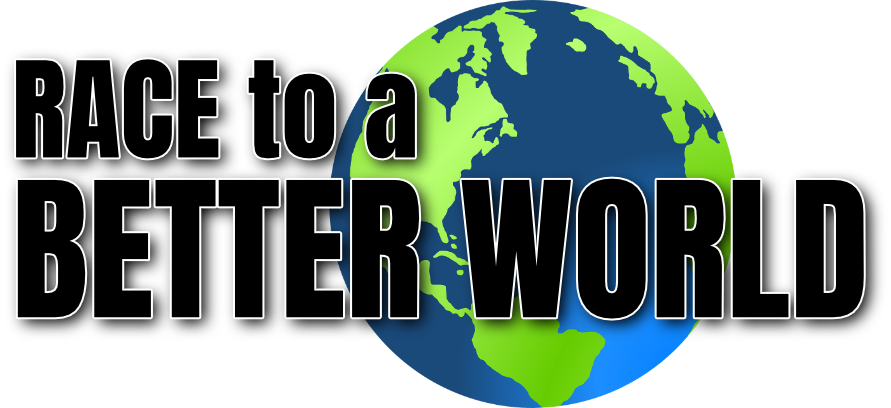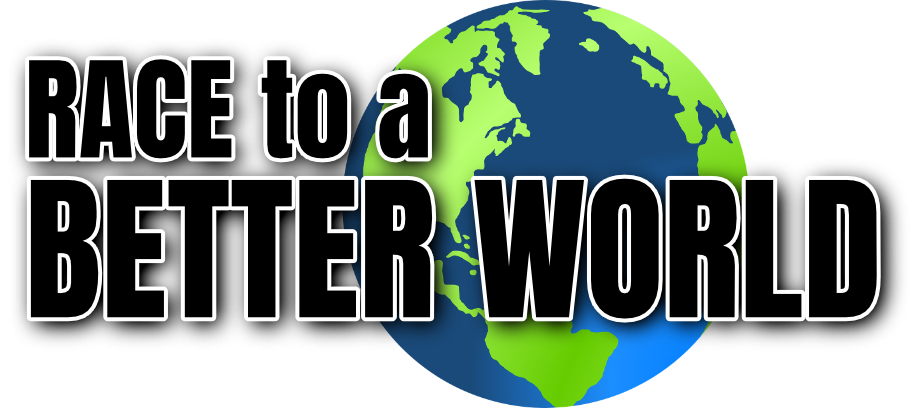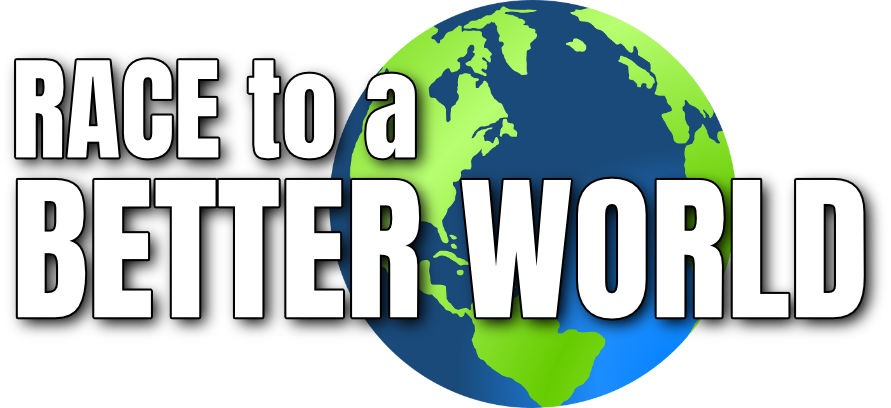Who We Are
THREE GENERATIONS OF
PEACE OVER PROFIT
The founder of this website Randy McDonnell comes from a
family legacy of putting peace over profit.
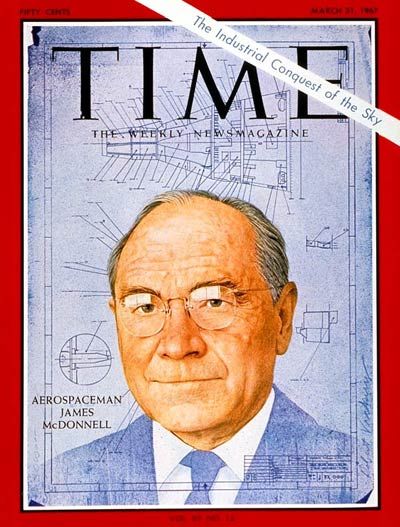
Randy’s great uncle was James S. McDonnell, affectionately known to millions as Mr. Mac. He started his company from scratch and lead it all the way to becoming the largest U.S. Defense contractor and military aircraft manufacturer. It was also the second largest commercial aircraft manufacturer in the world and NASA contractor, largest of what would now be called cloud computing centers and one of the largest rocket and missile manufacturers. After his death in 1980 the company would buy Hughes Helicopter, the company that had built all of Howard Hughes aircraft including the Spruce Goose.
He would inspire 8 additional McDonnells to enter aviation over four generations. Three McDonnell engineers would be CEOs of the family company. Companies that don’t have leaders that love and understand aircraft tend to fall behind in the race to better products. McDonnells have been continuously involved in aviation for more than 100 years with over 250 man-years as of 2014. Today 6 of those McDonnells in aviation were engineers. This compares to 18 years for aviation enthusiast and businessman Bill Boeing and 2 engineers with 62 man-years in aviation for the Wright Brothers.
Mr. Mac was born four years before the Wright Brothers at Kitty Hawk, when there were still many horse-drawn carriages and wood burning trains. He called his fellow workers teammates. He liked the name Comrades even more but the soviets claimed that title first. He was a supporter of the League of Nations and then the United Nations. In 1958 his company, McDonnell Aircraft, became the first organization and only company in the world to celebrate United Nations Day as a paid holiday. He was dedicated to peace and he was most often heard saying, “Peace can only be waged from a foundation of strength.” His company had a preliminary design of a manned spacecraft before NASA even knew they needed one. McDonnell would produce the free world’s first spacecraft Mercury and Gemini and the free world’s first space station and the first large space station, Skylab. He was so interested in space exploration because he saw it as one of the means for waging peace.
“To achieve the basic purpose for which we are here, the individual must have freedom to discover and to create and to grow in spirit. Astronautics provides us with a tremendous opportunity to do just this. As a part of waging the peace, we need many psychological substitutes for war as outlets for the creative, restless, adventurous, competitive souls of mankind. The creative conquest of space provides such an outlet. It can serve as competitive substitute for war if mankind will grasp this wonderful opportunity.”
He would become the most financially successful of the early aircraft manufacturers. When Jimmy Doolittle was asked what the challenges were in early aviation he said “starvation.”
Mr. Mac would spend whatever it took if it made sense but was otherwise a fierce defender of the American taxpayer. During one shareholder meeting he allowed his nephew Sandy McDonnell to host the meeting and he sat in the crowd. Afterward he sent a note to Sandy saying that most shareholders have their own pencil and those that don’t can share so please eliminate the yellow pencils for future meetings. Those pencils were already only a few inches long and had no eraser.
Mr. Mac also had no air conditioning in his home in St. Louis which gets very hot and muggy in the summer. He had fans because they were more efficient. His wife finally put her foot down and insisted they put a window air conditioner in their bedroom so she could sleep at night.
When Sandy McDonnell went to work for McDonnell Aircraft, Mr. Mac asked him if he wouldn’t like to start work at the hourly rate of a janitor so he could say in the future that he had worked his way up from a janitor’s pay. Sandy said essentially that it sounded great but he was about to buy a house and now had a wife and baby girl and would be happy to say that he started at the lowest pay for an engineer even though he had just come from an important job on the Manhattan Project.
Randy’s grandfather, Bill McDonnell, lived longer, so was on the board of directors longer, than his younger brother, the founder of McDonnell Douglas. He led the finance committee that helped McDonnell Douglas grow and acquire Douglas Aircraft, which Mr. Mac wanted in order to move away from military weapons production. During the depression, Bill’s partners in banking declared bankruptcy. Bill, however, not only honored his own debts but paid off the debts of all his partners, which required him to sell his home and move in with his in-laws. He would quickly become a very wealthy man again.
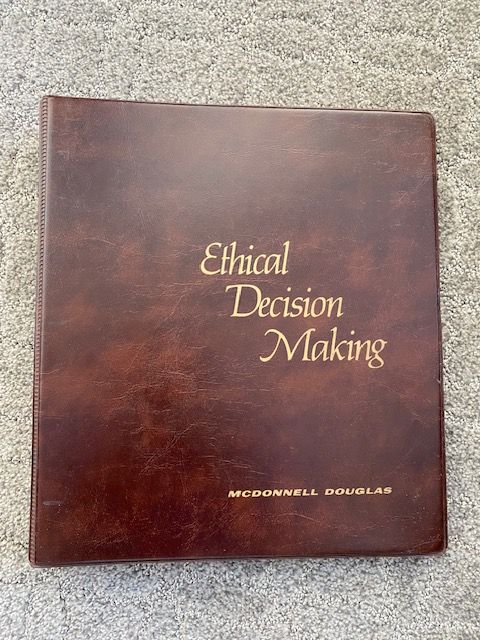
Randy’s father Sandy McDonnell worked on the Manhattan Project in charge of figuring out how to pour the Uranium in a vacuum into the first nuclear bombs so it wouldn’t burn up and create a deadly radioactive cloud. Despite that and working his way up to President and CEO of McDonnell Douglas, the United States largest defense contractor, he would be the most active among the 2nd generation of McDonnells in promoting peace and prosperity. He spent the last 32 years of his life trying to raise the ethical standards of himself, McDonnell Douglas and then the rest of the world.
He provided ethics training to many millions of students in kindergarten through 12th grade. He has been called the father of Character Education and founded CharacterPlus.org and was founding Chairman of Character.org. While he was Chairman and CEO of McDonnell Douglas, he was also President of the 4-million-member Boy Scouts of America from 1984 to 1986. He was so proud of that organization’s work to develop character in young men.
At McDonnell Douglas he instituted the strictest code of ethics and ethics training of any defense contractor. He also tried unsuccessfully as President of the Aerospace Industries Association to get other aerospace firms to follow McDonnell Douglas’ lead.
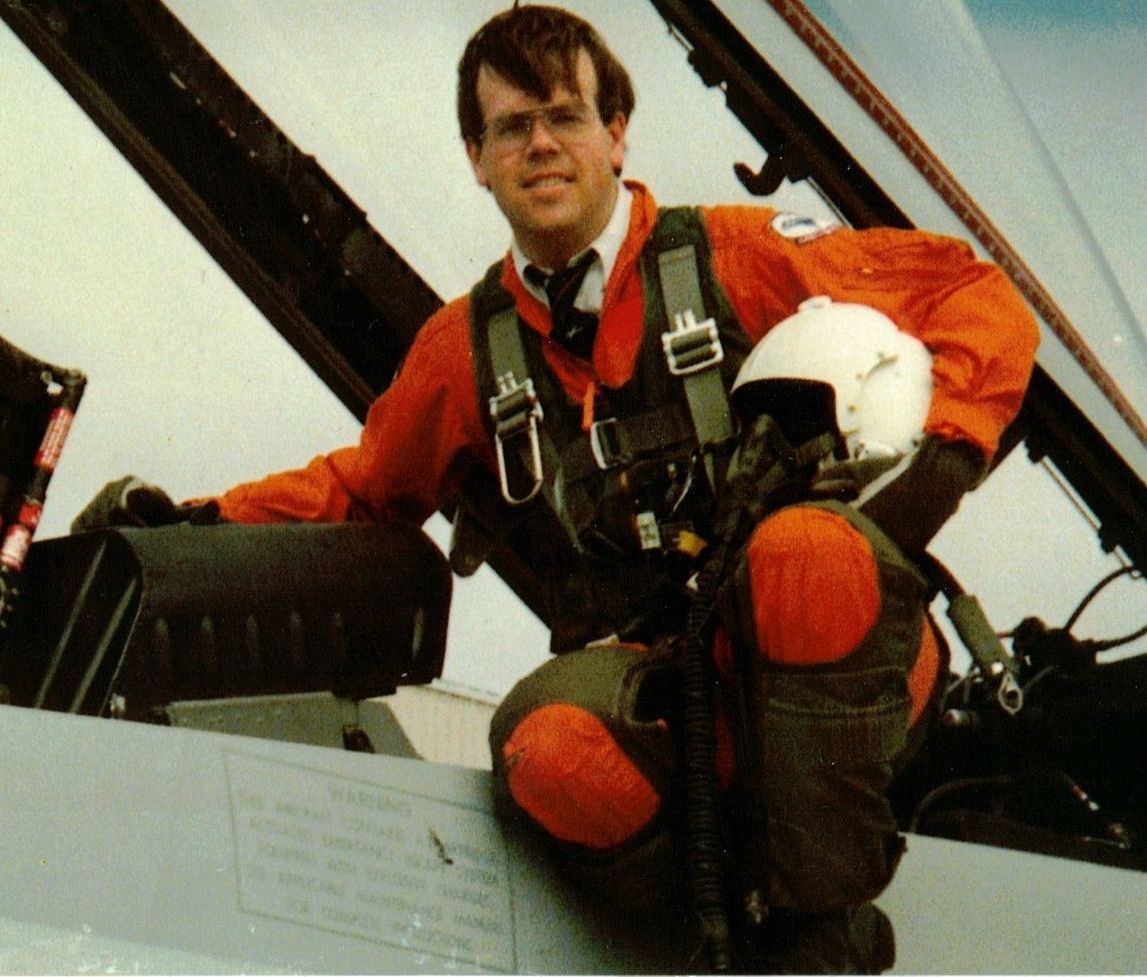
Randy McDonnell is doing the most in the third generation to put peace over profits. For decades he supported his father’s efforts in character development and served on the boards of both Character.org and CharacterPlus.org.
He was also Chairman of the Executive Advisory Board of CharacterPlus.org. He was also on the Board of the Greater St. Louis Area boy Scouts of America. Randy has been working for peace for a long time. Three weeks before 9-11-2001 he sent a letter to Goerge W. Bush warning of the threat of islamic terrorism and how to create peace by resolving the Palestinian-Israeli conflict. Randy received a letter back from George W. Bush dated the day after 9-11-2001 saying he would share Randy's memo with his staff. Randy's suggestion wasn't followed and you know the rest of the story. However, you can see the summary of the idea on the website FixAllDemocracies.com. Randy still believes it is the best solution today (other than the RACE TO A BETTER WORLD).
In August 2023 he created the website FixAllDemocracies.com to fix 120 democracies representing over 58% of the world’s population. At the same time, he created the sister website RaceToABetterWorld.com to create a more peaceful and prosperous world.
Randy has designed, as a one-man company without even a secretary, the technology behind some of the United States’ most successful aerospace products, most of which can be used in warfare. However, he appears intent on eliminating that market for his inventions.
WHO WE ARE
& how we got here
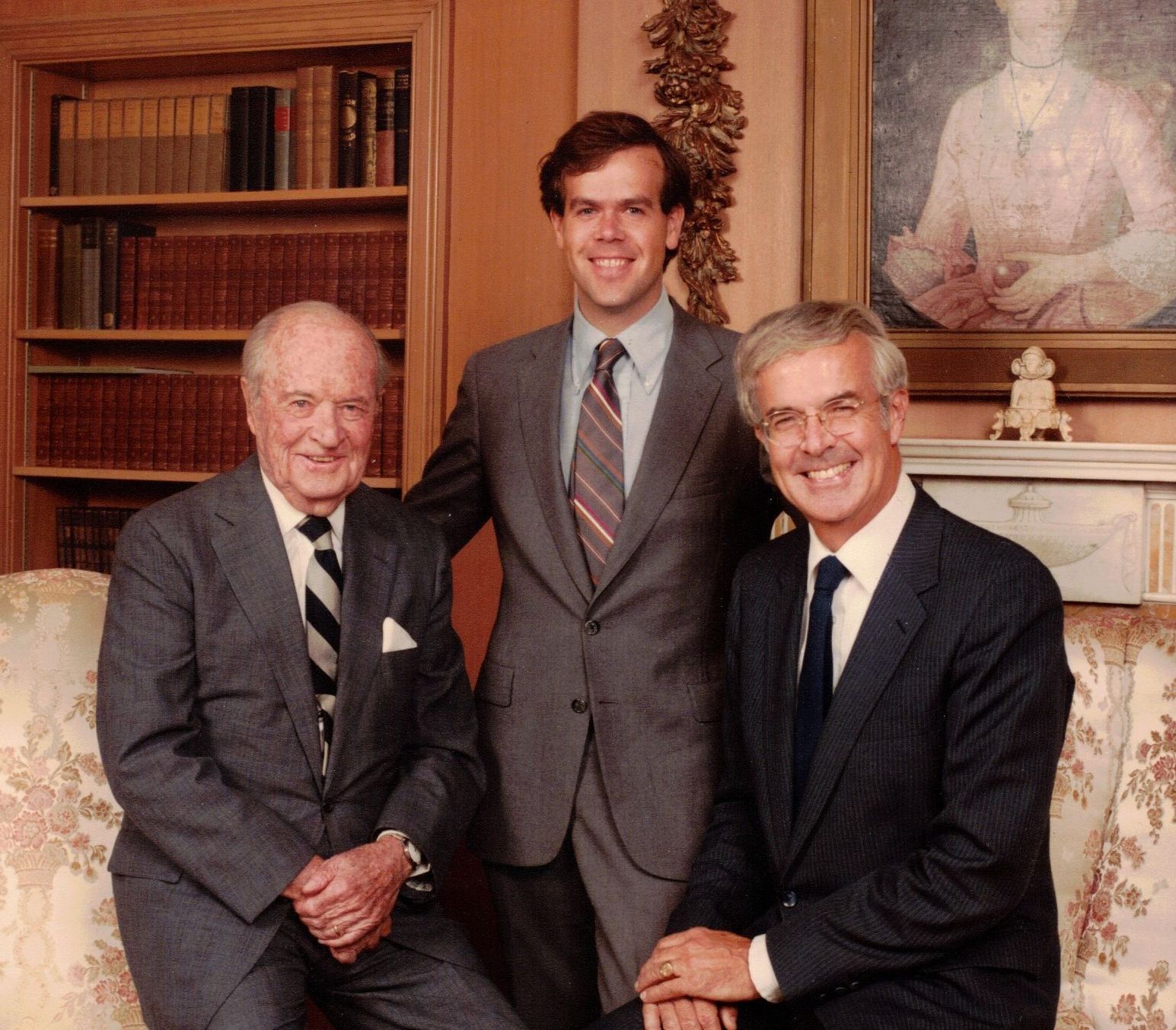
Growing up, Randy and his sister Robbin, had identical-twin nannies named Edna and Emma that were hard to tell apart. Both nannies told his mother they thought it was strange that Randy would spend all day in his room humming, perfectly content by himself daydreaming. His mother told him that he would never have friends if he didn’t make the effort. Randy didn’t care.
As a child, Randy recognized that he was innovative and liked to find solutions to problems. When he was 12 years old his father told him how radar worked and within a few weeks he had sketched up a stealthy radar satellite that doubled as a rocket nose cone that would have worked.
This was in 1963, 25 years before the idea of stealth was generally seen as a possibility and also before the first radar satellite was secretly launched. Like most dreamers, Randy would have more inventions than he could remember.
As a result, Randy wanted to go into advanced design when he started working at McDonnell Douglas. However, his father wouldn’t allow it. He wanted Randy to follow him and his great uncle to hopefully one day be Chairman and CEO of McDonnell Douglas. However, Randy was very shy and didn’t think he could be a good manager. Fast forward to 1985.
Randy’s father is Chairman and Chief Executive Officer of McDonnell Douglas, the company named after Randy’s great uncle, James S. McDonnell who was affectionately known to millions as Mr. Mac. It is the United States largest defense contractor and military aircraft manufacturer, largest of what would be called cloud computing today, second largest commercial aircraft manufacturer and NASA contractor in the world, and one of the largest helicopter, missile and rocket manufacturers in the world.
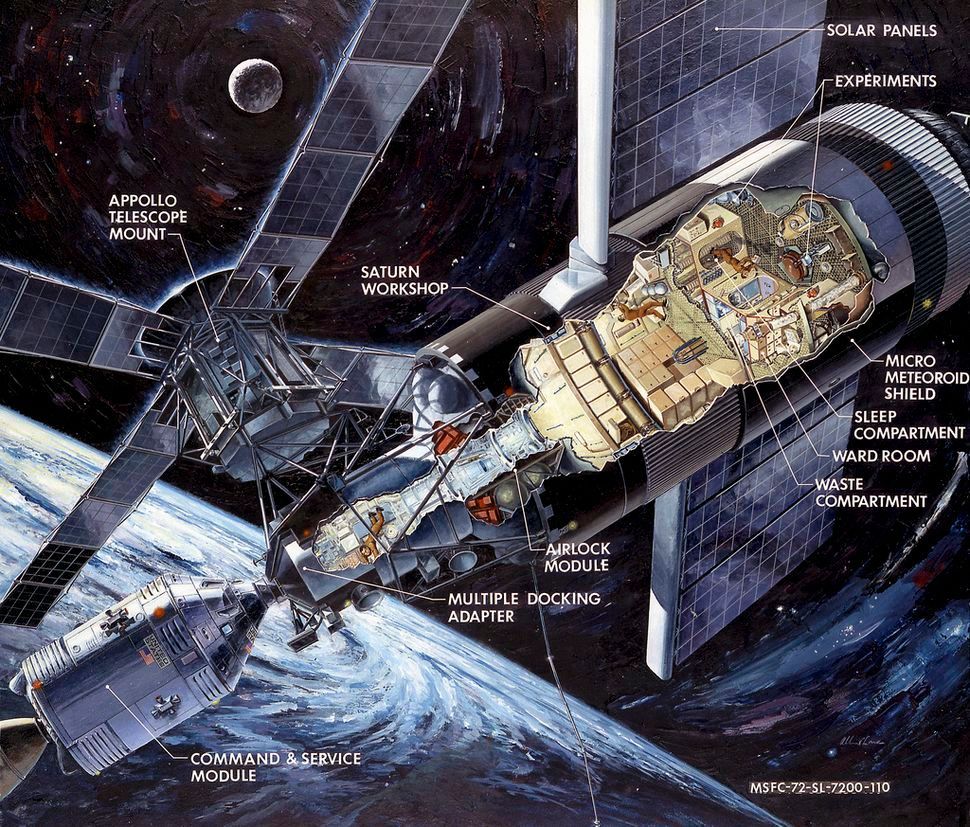
Randy’s father had just instituted the most comprehensive ethics program in the industry and Randy is going for his 8-hours of training in business ethics that all employees have to go through.
He isn’t sure how just 8-hours of training will be enough to understand the complexity and subjectivity of business ethics. He is stunned when the entire 8 hours focuses on just the 12 words “Make decisions that maximize the benefit to everyone affected by those decisions” and how to make those decisions with examples. A light bulb went off in his brain. Oh my Gosh, it was that simple. Those 12 works allowed anyone to figure out objectively what is right and what is wrong. Are pro-life advocates right or pro-choice? When should you tell the truth and the rare exceptions when you should lie? It was also the way to maximize peace and prosperity and extend the potential for humans to survive and thrive long into the future.
Also, it was the easiest way to get the cooperation to get what you want because it helps everyone.
He realized that if the wisdom behind these 12 words was spread around the world, it could prevent many wars. In the past, if a president of a country felt he wasn’t going to get re-elected he might start a war to get his citizens to rally behind him. If everyone knew and understood the significance of these 12-words a President would never consider starting an unnecessary war. A war is the opposite of maximizing the benefits and he would lose the support of his people.
It is also the easiest way to achieve greater prosperity. If you are competing on a rowing team and some members are rowing backwards, the easiest way to improve your performance is for everyone to starting rowing in the right direction.
Randy recognized how powerful these 12-words were. Randy believes that if his father’s ethics training program had been at Douglas Aircraft before the merger in 1967, McDonnell Douglas would now be dominating both military and commercial aircraft and Airbus probably wouldn’t exist. You can read why he believes that by reading to the end of this article.
Fast forward to late July 2023 when Randy decided to fix the 120 democracies that represent over 58% of the World’s population. He did this as a way to get the world-wide visibility to spread the wisdom of the 12 words around the planet with RaceToABetterWorld.com.
In the RACE TO A BETTER WORLD, instead of the athletes entering the arena for the opening and closing ceremonies alphabetically by country they could enter based on their country’s position in the RACE TO A BETTER WORLD and their national leader could be honored with his or her picture on a giant screen above the arena. And/or the runners in the torch relay could be from countries closest to the top of the RACE TO A BETTER WORLD with the runner from the lead country at the end of the relay and lighting the Olympic flame. During the Olympics as their citizens cheer on the athletes, the athletes can cheer on their citizens to move their country forward in the RACE TO A BETTER WORLD. A special honor could be given in the closing ceremony to the top 10 countries that had moved the farthest forward during that Olympics.
Randy decided to add the words.. “Commit to reward and demand of each other that we all”…(before the 12 words of)…make decisions that maximize the benefit to everyone affected by those decisions.
That was because people often like to violate authoritarian rules but they respond well to peer pressure. That is probably because we evolved in tribes and anyone who didn’t respond well to peer pressure was kicked out of the tribe and didn’t survive.
It occurred to Randy in late July 2023 that he could apply the wisdom of the 12-words to both solve the conflict in Ukraine while also getting the world-wide visibility and support needed for the RACE TO A BETTER WORLD.
The process for making maximizing decisions is to first try to give everyone what they want. Vladimir Putin uniquely has the power to fix the problem and it appears he just wants to restore the glory and prestige of the former Soviet Union. His country is already the world’s largest covering 11 time zones so adding Ukraine wouldn’t make a significant difference. If Vladimir Putin brings peace to Europe and unity to Ukraine, he will also spread news of the RACE TO A BETTER WORLD like nothing else could. He will also demonstrate the power of making maximizing decisions. As a result, no other leader and country either before or after him will be able to claim they have done more to extend the potential for humans to survive and prosper long into the future.
Putin is now in the best position to bring peace to the biggest conflict in Europe since World War II. The RACE TO A BETTER WORLD will spread knowledge of Russia’s important role in bringing peace in World War II. In addition, Russia has what Randy believes is one of the most impressive, dramatic and inspirational statue in the world, the Motherland Calls statue. It is the perfect backdrop to the RACE TO A BETTER WORLD, its international museum and the incredible sacrifice that Russians endured to bring peace to the world at Stalingrad. This statue dwarfs the statue of Liberty in New York Harbor and is the largest statue in the world of a woman. Yet until now, few people outside of Russia, including Randy knew about it.
THE DRAMATIC IMPACT OF THOSE 12-WORDS ON THE COMMERCIAL AIRCRAFT INDUSTRY IN THE UNITED STATES
Randy recognized how powerful these 12-words were. If people or corporations don’t live by high ethical standards, they can potentially win battles but will eventually lose the war. Randy’s father had told him many times that Boeing would eventually lose the war because they didn’t have a focus on ethics. The 12-words gave McDonnell Douglas the means to always chose the most ethical approach and the military really appreciated it. A former McDonnell Douglas top executive told Randy that the military was so impressed with McDonnell Douglas’ ethics program that they asked if they could duplicate it in the military.
If his father’s ethics training program had been at Douglas Aircraft before the merger in 1967, Randy believes that McDonnell Douglas would now be dominating both military and commercial aircraft and Airbus probably wouldn’t exist.
In 1967, at the time of the merger, the airlines were asking for a twin-engine aircraft a little larger, but around the size of the existing stretched Douglas DC-8. They wanted an aircraft with the new, quiet, high efficiency engines like the CF-6. Randy remembers his father talking about the obvious potential advantages of a twin-engine version of the DC-8 with Bob Hage. It would require a number of changes to the aircraft including a longer landing gear to achieve the ground clearance for the larger diameter engines. However, this might allow it to be stretched even further for higher passenger capacity. The original DC-8 was way down the learning curve and in widespread airline service and was built so well the FAA had given it unlimited airframe life if properly maintained.
Remarkably, Douglas Aircraft was demanding that McDonnell Douglas develop the much more expensive all-new DC-10 that didn’t meet Mr. Mac’s criteria for developing a new aircraft. Mr. Mac was the founder of McDonnell Douglas and Randy’s great uncle. The DC-10 didn’t appear to have a breakthrough technology that couldn’t be retrofitted on existing aircraft. However, Mr. Mac had always been grateful to Donald Douglas Sr. for giving him his first big contract in World War II for aft fuselage sections of the C-47/DC-3 aircraft. In addition, Mr. Mac was just entering the large commercial aircraft market and Randy believes that he must have trusted that their judgement might be better than his.
Up until this time, Randy believes Mr. Mac had an almost perfect record of decision-making. He very carefully considered his options sometimes for frustratingly long periods of time for those waiting for the decision but he invariably came up with potential problems that others hadn’t thought of. Randy believes this was one of the few times he made the mistake of over-riding his own good judgement.
Before too long the airlines started coming back to McDonnell Douglas to buy more four-engine DC-8s. Sandy McDonnell would tell his son Randy that he, Mr. Mac, and the airlines were astounded to hear that the Douglas Aircraft division had cut up the tooling for the DC-8 without telling them or getting their permission. The airlines were limited to retrofitting new high-bypass ratio engines themselves on their existing four-engine DC-8s and did. The airlines, however, had wanted a twin, which is more economical to buy and operate.
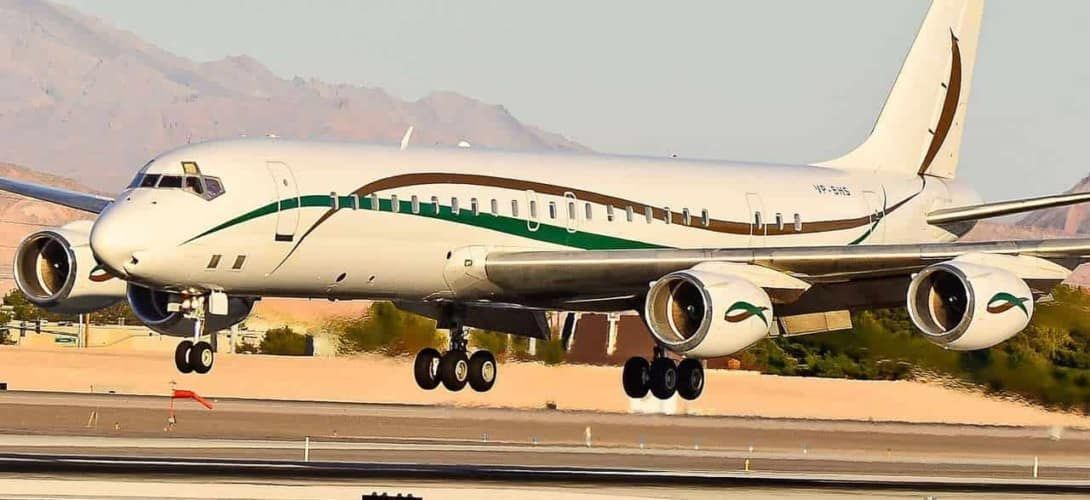
Randy believes that Douglas Management had done what they thought was in their best interest, namely getting a huge commitment from corporate to pursue the commercial aircraft business with the DC-10, but wasn’t in the best interest of the combined corporation and McDonnell Aircraft that had just saved them from bankruptcy. It didn’t comply with the 12-word rule. As it turned out it was a disaster for the Douglas division also. If Douglas had developed a twin DC-8, like the airlines were looking for, Randy believes that Airbus wouldn’t have seen an opening to get into commercial aircraft with the A300 and probably never would have. Douglas would have beaten Boeing by over a decade to the twin-jet market that still almost totally dominates today. Mr. Mac didn’t like spending money if it didn’t make sense but was willing to spend as much as it took when it did. McDonnell Douglas could have established a family of twin-engined airliners with the commonality of parts and training that probably would have been unstoppable by either Boeing or Airbus.
It’s hard to imagine that Boeing could have ever caught up because they had made the almost fatal mistake of developing the 747, a four-engine aircraft without the significant breakthrough technology that would warrant such a big gamble. Boeing apparently was counting on passenger air miles to keep climbing 15% or so a year like it had since World War II. That didn’t happen and by 1971 Boeing was so close to bankruptcy that a billboard outside Seattle on April 16th said, “Will the last person leaving Seattle-turn out the lights.”
More than half of the early 747 sales were because the airlines needed the range but not the size. As close as they already were to bankruptcy, a DC-8 in both two and four engine versions that was very inexpensive to buy and operate and had commonality with the airlines’ existing fleet could have dramatically cut into their sales. Randy believes someone would have had to buy Boeing in the 70s like McDonnell Aircraft had bought Douglas in the 60s to keep them operating. Boeing was lucky to eventually do well on the 747 after the market grew and the enormous development cost of such a big aircraft helped them keep a monopoly on the large aircraft market for a long time. Randy believes that McDonnell Douglas with a family of more economical large twins under the 747 could have changed things dramatically.
In 1971 Lockheed was also on the verge of bankruptcy because of the large cost of developing the L-1011. McDonnell Douglas was the only U.S. commercial aircraft manufacturer not close to bankruptcy and they would have been even better off if they had pursued re-engined DC-8s instead of the DC-10. Lockheed put up an enormous lobbying effort to get the U.S. government to bail them out. Mr. Mac was asked to testify before congress but decided not to, figuring that his testimony wouldn’t make much difference. Randy remembers his father telling him that Mr. Mac would soon learn to regret it when the bailout passed by only one vote and McDonnell Douglas was left with the DC-10 competing against the almost identical L-1011 in a market that could hardly support one of them.
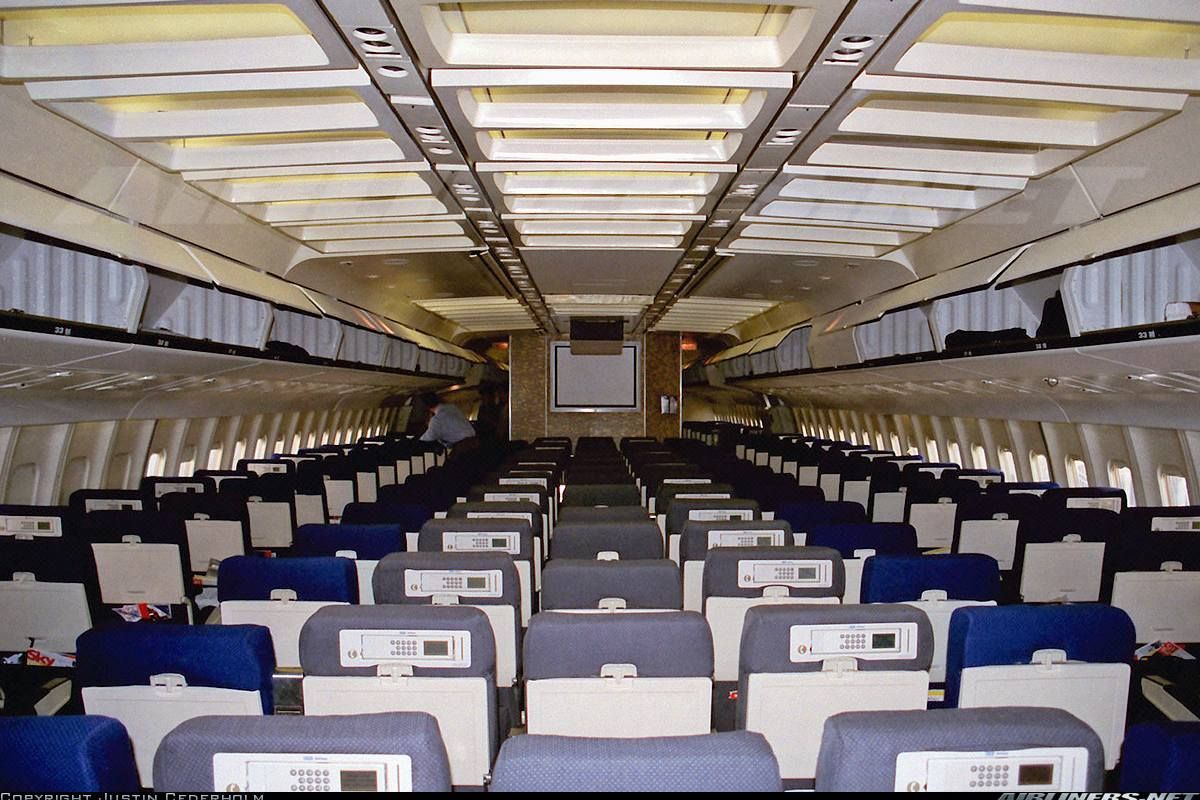
Randy was about to board a flight with John McDonnell and his father Sandy when they realized it was a Lockheed L-1011. Like most people they didn’t pick their flights to make sure they got a McDonnell Douglas airliner. After the L-1011 had been airborne for a while and far from a suitable landing spot, smoke started coming out of the vents indicating there was a fire somewhere in the aircraft. Instead of seeing this as a negative development, John McDonnell shouted as loud as he could “What kind of aircraft is this!!” The rest of them shouted out “A Lockheed L-1011.”
After the DC-10 was launched, Douglas management continued to come to Mr. Mac claiming they had identified a hole in the market and needed another big commitment to commercial aviation. Mr. Mac famously said, “Just because there is a hole in the market doesn’t mean I have to fall into it.” Randy believes Mr. Mac realized he’d been led astray once by Douglas management, but wouldn’t be again.
Douglas also had the disadvantage of the higher cost of living in Los Angeles relative to Seattle, the more difficult commute, the more stringent environmental laws such as against chemical milling and a poorer work ethic.
Mr. Mac was astounded when he went out to Douglas and found they were serving alcohol during the day in the executive dining room and that workers went off company property for long lunches. A prostitute ring was found operating out of one of the company’s parking lots and in the middle of the week people were thinking about what they were going to do on the weekends.
In 1984, McDonnell Douglas bought Hughes Helicopter for $470 million which was the company that had built all of Howard Hughes aircraft and helicopters including the Spruce Goose.
In 1986, the helicopter company called Sandy McDonnell to see if his son Randy would come down to lead the Superteam, a teaming of McDonnell Douglas Helicopter, McDonnell Aircraft and Bell Helicopter to pursue the LHX helicopter program that was anticipated to be the Army’s largest procurement program ever. The U.S. Army wasn’t convinced that the helicopter company was fully behind the program because if it went ahead, it could replace their already very successful Apache helicopter.
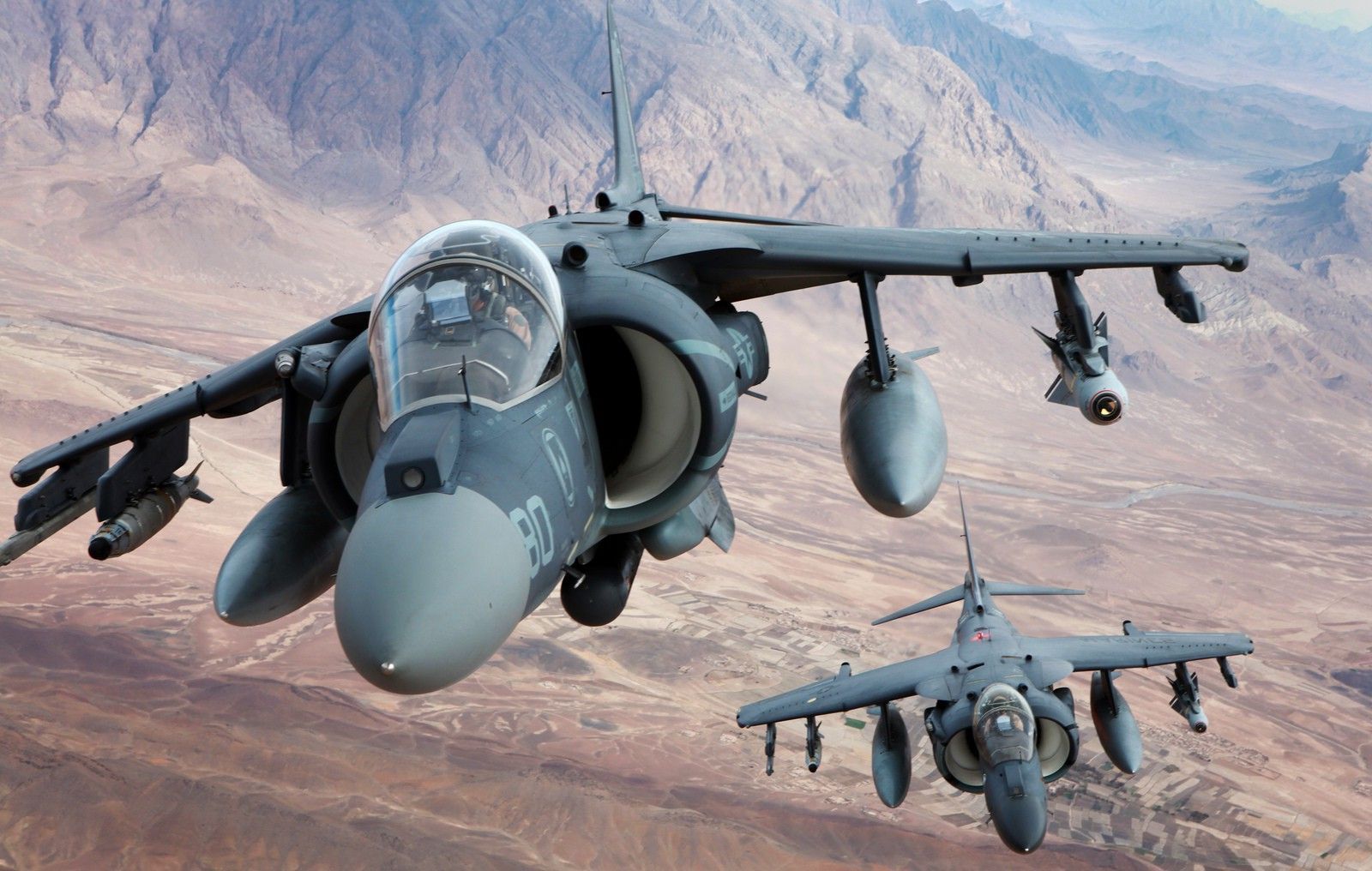
However, Randy was already program manager of the very successful V/STOL AV-8B Advanced Harrier attack fighter. If the boss’ son was willing to leave that very successful program to go on the LHX program it would be the best way to prove to the U.S Army their commitment to the program.
Randy was willing to take a hit for the team and loved the idea of living in the beautiful southwest. As he was driving into the Phoenix area, he was so excited he got a speeding ticket. It was April fool’s day and he would eventually realize what a fool he was. Before he left, Randy kept telling his father, during their weekly lunches or dinners, to sell Douglas Aircraft and not develop the MD-11. Randy was program manager on the AV-8B Harrier program but in his spare time was working on the breakthrough he felt would allow McDonnell Douglas to leapfrog over Boeing and Airbus in commercial aircraft and stay on top in military aircraft as well.
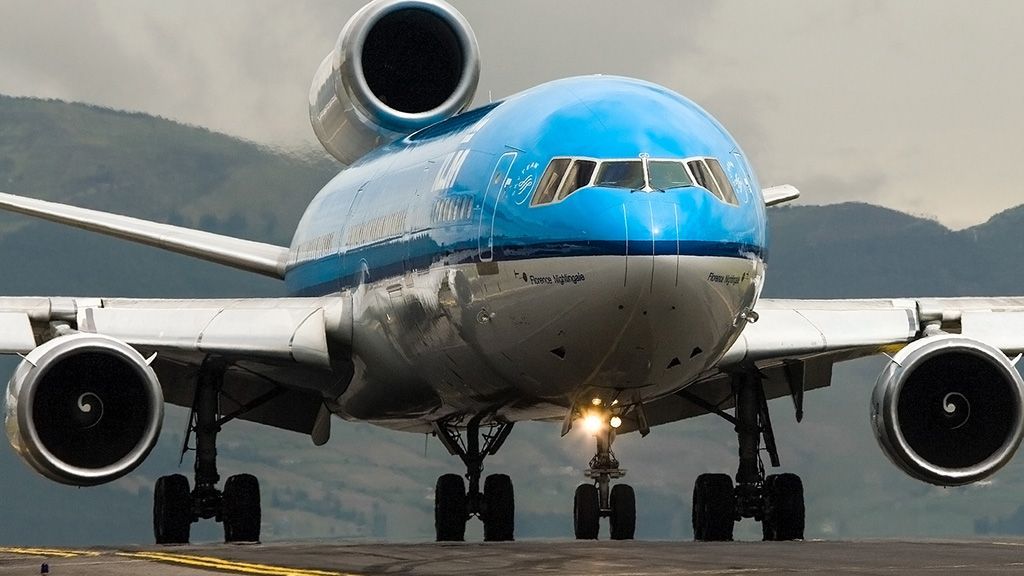
However only 8 months after leaving Saint Louis, in December 1986, his father gave in to Douglas Management pressure to develop the MD-11. If Sandy had a fault as a manager, it was that he cared too much for the people that worked for him and gave in to the squeaky wheels without considering the impact to everyone else. Randy believes he hadn’t followed the 12-word advice in his own ethics training program which had only been started the year before and Randy believes probably hadn’t gotten to Douglas management yet.
Randy believes that his father knew that the MD-11 didn’t have enough of a breakthrough technology to warrant it and they would be lucky to break even. Randy believes if he had been back in St. Louis, and thus knew what was happening, he could have kept his father from agreeing to the MD-11 program. Mr. Mac was never into generating sales at the risk of losing profits. The company at the time had a significant backlog of MD-80s and things were looking promising for the first time in a long time. In addition, other countries were potential buyers of Douglas and interested in getting into the prestigious commercial aircraft business and this would have been a good time to sell.
So again, Randy believes that Douglas Management had applied a large amount of pressure to do what was right for them, but not right for the corporation or McDonnell Aircraft, the company that had saved them from bankruptcy 19 years earlier. The MD-11 would go on to lose money and in 1995 a pre-tax write-off would be taken of $1.838 Billion.
In 1988, Mr. Mac’s son John McDonnell became chairman and CEO of McDonnell Douglas. Randy was confident that John wouldn’t make the mistake of giving in to Douglas management pressure and would make the correct decision of either selling Douglas or letting the commercial aircraft production wind down. Ever since the merger with Douglas in 1967, Douglas had been a drain on the remarkably profitable military business of McDonnell Aircraft that was producing lots of cash.
John McDonnell had set the goal of making McDonnell Douglas the pre-eminent aerospace company in the world. With the very profitable fighter business and C-17 production McDonnell Douglas could wait until the right breakthrough technology came along to leapfrog over Boeing and Airbus in commercial aircraft and leave them behind. Randy had also briefed John on the breakthrough technology that Randy was working on that could be that breakthrough.
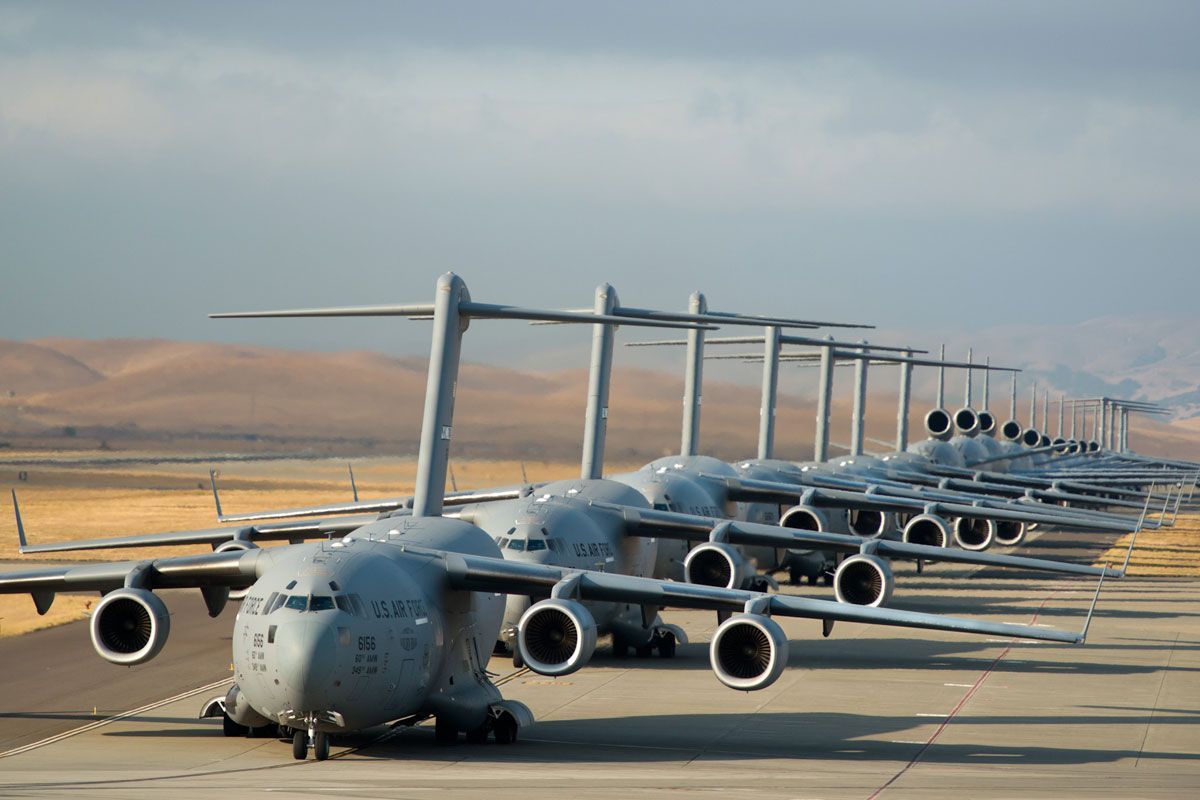
Based on Chapter 6, “Meltdown and Merger” of the book “Boeing versus Airbus” Boeing in 1996 had gotten into remarkably similar problems to Douglas Aircraft exactly 30 years earlier.
Dean Thornton had been replaced by Ron Woodward as president of Boeing’s Commercial Airplane group. Woodward was a salesman and decided that he could run Airbus out of business by dropping aircraft prices up to 30%. Frank Shrontz had been replaced by Phil Conduit as CEO, who was an engineer and wasn’t reviewing and approving the pricing decisions. Later, Boeing would find out that Airbus actually had a 12 to 15% lower cost of building aircraft. They had picked the wrong time to start a price war.
Also, Boeing had offered an early retirement plan and too many engineers and production line workers had taken it. They were also hit with a sixty-three day strike that began in late 1996. They had to scramble to hire back inexperienced workers and they were behind schedule and having to pay late delivery fees to the airlines. The production line was in shambles with aircraft being worked on out of sequence and there were many part shortages.
In 1996, Boeing heard that McDonnell Douglas was about to make a big purchase of at least one major aerospace electronics firm and approached Harry Stonecipher to merge Boeing and McDonnell Douglas before that happened. Boeing probably needed the large amounts of cash that McDonnell Douglas was now producing partly because McDonnell Douglas was no longer trying to prop up their commercial aircraft operations.
The media claimed that McDonnell Douglas’ increased profitability was proof of McDonnell Douglas’ philosophy of near-term profits over long-term engineering dominance. Instead, it was a case of McDonnell Douglas deciding to make more profit and wait to leapfrog over Boeing and Airbus with new technology that Randy was working on or some other technology that might come along. Randy, as a one-man company without even a secretary, would finally refine that technology less than 5 years after the merger and still doesn’t understand why John McDonnell didn’t wait for it. Neither he, Sandy or Mr. Mac would have agreed to the merger unless McDonnell Douglas was the surviving company and its ethics program was preserved.
Randy believes from reading the book “Boeing versus Airbus” that Boeing wasn’t truthful with the stock market about the condition they were in and this was another ethical failure that didn’t follow the 12-word rule. On page 129 of “Boeing versus Airbus” it says that Business Week reported that..
…”several inside witnesses indicate that Boeing did more than simply fail to tell investors about its production disaster. It also engaged in a wide variety of aggressive accounting techniques that papered over the mess…Critics say the company should have taken charges for the assembly-line disaster in 1997, even if it meant jeopardizing the McDonnell Douglas merger.” Boeing would settle a lawsuit from its own stockholders in 2001 that claimed Boeing “should have recognized much of [the] known production inefficiencies in the June 30 quarterly financial statements. No such recognition was made due to Boeing’s…desire to maintain [the] stock price until the merger with McDonnell Douglas was complete.” (page 129 Boeing versus Airbus).
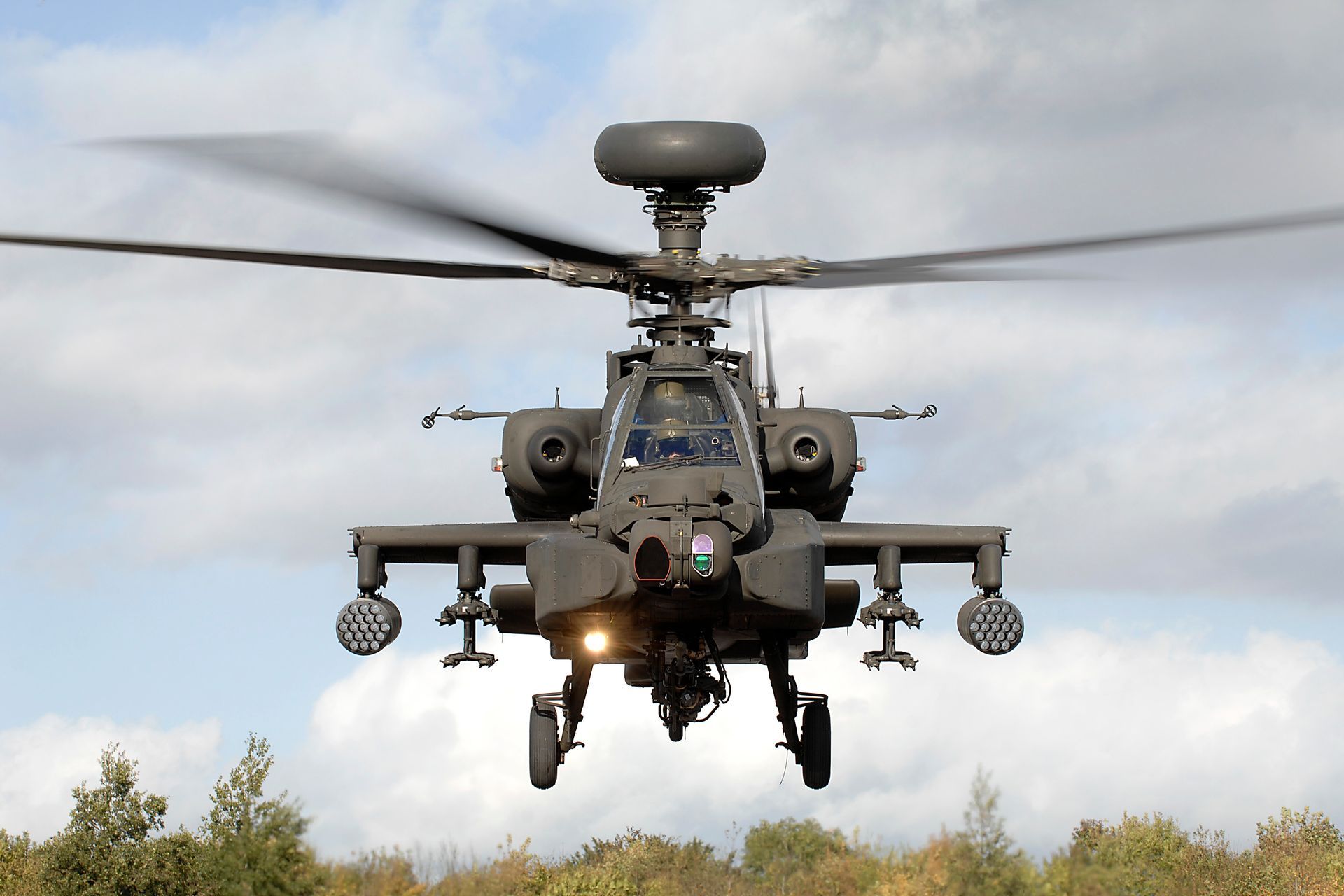
Before the merger Boeing leadership…
“…began a vigorous campaign aimed at showing that Boeing would make $3 billion in 1997. But the skeptics had information that clearly pointed in the other direction, indicating that the company would be lucky to finish at zero in that year. The data were about $4 billion apart. An idea to close some plants and redesign the company was spiked.” (page 126, Boeing versus Airbus)
Even with the profits from the former McDonnell Douglas, which had record profits the year before, the new Boeing ended up writing off $2.6 billion in 1997 per the book “Boeing versus Airbus.”
The merger was a stock swap so Boeing effectively bought McDonnell Douglas with its own money. The McDonnell Douglas finance company that had been established in 1968 to finance the airlines to buy Douglas Aircraft became the Boeing Capital Company to now help finance Boeing Aircraft.
However, Boeing employees started to characterize the merger as just the opposite, namely McDonnell Douglas buying Boeing with its money. This probably was because many employees from McDonnell Aircraft in Saint Louis went out to Seattle to fix the problems at Boeing, and employees there probably didn’t like it. Randy believes that despite the major Boeing employee campaign to make it look like Boeing had saved McDonnell Douglas, instead of visa-versa, at least some of the analysts weren’t fooled. On page 138 of “Boeing versus Airbus” it says, “ a few of the Wall Street analysts argued that the merger had saved Boeing, a company, they said, that had no cost controls and had forgotten how to run a business on cash.”
Also, John McDonnell and Harry Stonecipher ended up on the Boeing board with more stock than other board members.
Boeing employees would continue to blame almost everything on the merger with McDonnell Douglas. One rumor was that McDonnell Douglas had a culture of finance over engineering that had damaged Boeing. Harry wasn’t an aeronautical engineer or even an engineer but had only been with McDonnell Douglas for a little over 2 years when the merger plans were announced. All the McDonnell family members that led McDonnell Douglas for 58 years were engineers and loved the product. From Mr. Mac on down, the company had re-invested most of their profits back into the business. In contrast, Boeing spent $43.5 Billion just between 2013 and 2019 buying back their own shares to boost prices and presumably executive stock option plan values. Randy believes that took away from investing in a re-engined 737 before being pressured to re-engine the 737 so quickly that they took shortcuts leading to the 737 Max problems. Randy believes that was another ethical failure that didn’t follow the 12-word rule.
Randy believes if Boeing had been truthful with the stock market, John McDonnell would have achieved his goal of making McDonnell Douglas the pre-eminent aerospace firm in the world by buying Boeing. As such Boeing employees would have been trained on the 12-word ethics program and there wouldn’t have been the stock buyback program or the 737 Max problems in Randy’s opinion. Randy believes you didn’t have to be an engineer to know you shouldn’t trust the flight safety of a 737 Max to a single angle of attack probe that could easily malfunction or be damaged and then not tell the pilots or the FAA the situation. This would have significant consequences for the American commercial aircraft industry.

Randy believes that Boeing probably had a good reason to be upset about Harry Stonecipher not being an engineer. Reportedly he ended up making decisions that shouldn’t have been made like subcontracting out composite assemblies on the 787 including the wing which is the technological heart of the aircraft and part of the company’s core competence. However, Boeing never appeared to give credit to former McDonnell Aircraft engineers that went out to Boeing to help them fix their composite problems. McDonnell Aircraft had a lot of experience in composites because of the F-18 and AV-8B wing designs.
Boeing employees reportedly would blame the McDonnell Douglas merger for bringing Harry Stonecipher and John McDonnell into Boeing and claiming that forced them in the direction of more emphasis on finances over engineering. However, Randy believes the Boeing board of directors should take responsibility for not replacing Harry. John McDonnell was on the Boeing board until 2011 but wasn’t married to Harry and in Randy’s opinion would have gone along with the other board members.
At McDonnell Douglas, John McDonnell was Chairman and an aeronautical engineer and Randy believes would have stopped him if Harry had considered a similar decision at McDonnell Douglas. Why didn’t Phil Conduit, also an engineer over Harry Stonecipher, do the same at Boeing? Also, Boeing had thrown out the McDonnell Douglas board of directors along with the McDonnell Douglas name that in the industry was most associated with high ethical behavior. When Sandy McDonnell was President of the Aerospace Industries association, he tried unsuccessfully to get all aerospace firms to adopt the McDonnell Douglas code of ethics and ethics training.
Randy believes that ethics is probably more at the heart of the problem than a lack of focus on engineering. As previously stated, Randy doesn’t believe you need to be an engineer to know not to risk the flight safety of a 737 Max like Boeing appears to have done and then after the fact try to deny that it was a bad decision and blame it on the pilots.
In Randy’s opinion, Boeing needs to at least adopt the McDonnell Douglas “12-word” ethics program and find a legacy of ethical behavior inside Boeing that they can point to for employees to follow.
A January 20th 2011 Reuters article claimed, “Many aviation experts say Boeing began to put a lower premium on in-house labor after its 1997 merger with rival McDonnell Douglas. That was the same year Boeing posted its first full-year loss as Airbus stole market share.”
Boeing’s loss that year wasn’t because of McDonnell Douglas, it was in spite of McDonnell Douglas making record sales and profits the year before and there is no indication, that Randy knows, that its profitability would have been much different in 1997 if reported separately from the rest of Boeing. It also wasn’t from Airbus stealing market share from one year to the next.
Per chapter 6 “Meltdown and Merger” of “Boeing versus Airbus” it had to do with Boeing issues like assembly line problems and the fact that Ron Woodward had sold aircraft at up to a 30% discount that Boeing realized in advance would have to be delivered at those low prices starting in 1997. Possibly a reason Boeing was so anxious to complete the merger with McDonnell Douglas before the end of 1997. Again, it appears that Boeing never corrected the media.
In the book “Boeing versus Airbus” it says that at Boeing’s annual leadership retreat in early January 2006 in Orlando Florida,
“Boeing’s general council Douglas Bain, who was also a senior vice president until he retired in 2006, delivered a savage indictment of reprehensible behavior routinely practiced. His speech was leaked to Dominic Gates and Alicia Mundy of the Seattle Times, and they quoted numerous passages.
McNerney [Boeing’s recently arrived Chairman, President, and CEO] was in the audience, and Bain began by saying, “As I walked up here, I think I heard Jim McNerney mutter, ‘Here comes Dr. Death.’ No one there was in any doubt about who had staged this show.
‘Was there a culture of win at all cost?’ Bain asked his audience. ‘We now know what that cost is.’ Boeing, he noted, faced possible indictments by U.S. attorneys on both coasts, and the Department of Justice assessment of damages exceeded $5 billion. Also, Bain added, Boeing could be barred from government defense contract or denied export licenses for both military and commercial sales. He responded that fifteen company vice presidents had been pushed out for various ethical lapses in recent years. ‘I found that to be an astronomically high number,’ he said.
‘There are some within the prosecutors’ offices that believe Boeing is rotten to the core,’ Bain said. ‘The U.S. attorney in Los Angeles,’ he said, ‘is looking at indicting Boeing for violations of the Economic Espionage Act, the Procurement Integrity Act, the False Claims Act, and the Major Frauds Act. The U.S. attorney in Alexandria, Va., is looking at indicting us for violations of the Conflict of Interest laws. And both are looking to throw in a few conspiracy and aiding-and-abetting charges, for good measure.
‘These are not zip codes,’ he said, as he read off the federal prison numbers of Darleen Druyun and Mike Sears. ‘How come in the year 2000 nobody said, ‘Should we really be hiring the relatives of our chief procurement officer of the largest customer we have on the defense side?’ Possible impending penalties, he said, include ‘a presumed denial of export licenses…both on the commercial and the government side,’ as well as ‘loss of security clearances, a possible suspension on bidding for space contracts or even total debarment from all government contracts on the defense side.
Bain ended with three questions: ‘Do we have a culture of silence? Where was management throughout all this? Is the problem the rank and file? Or is the problem with us?’
The media would criticize McDonnell Douglas for Mike Sears’ improper hiring of Darleen Druyun while at Boeing, but Randy believes he would never have dared do anything like that at McDonnell Douglas. He had been at Boeing for 5 years and Randy believes that he probably knew about the “win at all cost” Boeing culture for decades before that, like Randy’s father did. It’s certainly not acceptable, but he probably felt that adopting the Boeing “win at all cost” culture was the only way for him to succeed at Boeing as a former McDonnell Douglas teammate. What happened during the merger certainly supported that belief. In addition, Randy believes the way individuals or an organization treat others, and their legacy, is a good indication of their ethics.
Boeing quickly purged the company of both the “McDonnell” and “Douglas” names. In comparison to Bill Boeing’s 18 years in aviation, McDonnell’s collectively had over 250 man-years involvement in aerospace as of 2014 and had 5 engineers out of the 7 individuals.
- Mr. Mac- 1923-1980- 57 years
- Bill McDonnell- 1948-89- 41 years
- Sandy McDonnell 1948-1988- 40 years
- John McDonnell -1961-1997 36 years
- James S. McDonnell III-1963-1991 28 years
- Randy McDonnell 1971-2014- 43 years
- Jeff McDonnell- 6 years
- William Sanford MacVittie 12 years
Emily McDonnell, Jeff’s daughter has recently entered the industry as another aeronautical engineer from Princeton.
Today the McDonnell family has 6 engineers that are or were in aviation with over 275 man-years in aviation.
Sculptures and portraits of Mr. Mac and Sandy McDonnell were removed from the company. A display about Mr. Mac and his role in founding and growing the company was initially removed from the company museum in St. Louis called the “Prologue Room.” The name “McDonnell Douglas” was removed from all the aircraft models in the Prologue Room and offices and replaced with “Boeing.” The enormous neon “McDonnell Douglas” sign that had long dominated the skyline around Lambert International Airport in St. Louis was taken down and eventually replaced with an enormous “Boeing” sign. A “McDonnell Douglas,” and before it, a “McDonnell Aircraft” sign had been there since soon after World War II. The St. Louis area also saw a drop in charitable donations from the corporation.
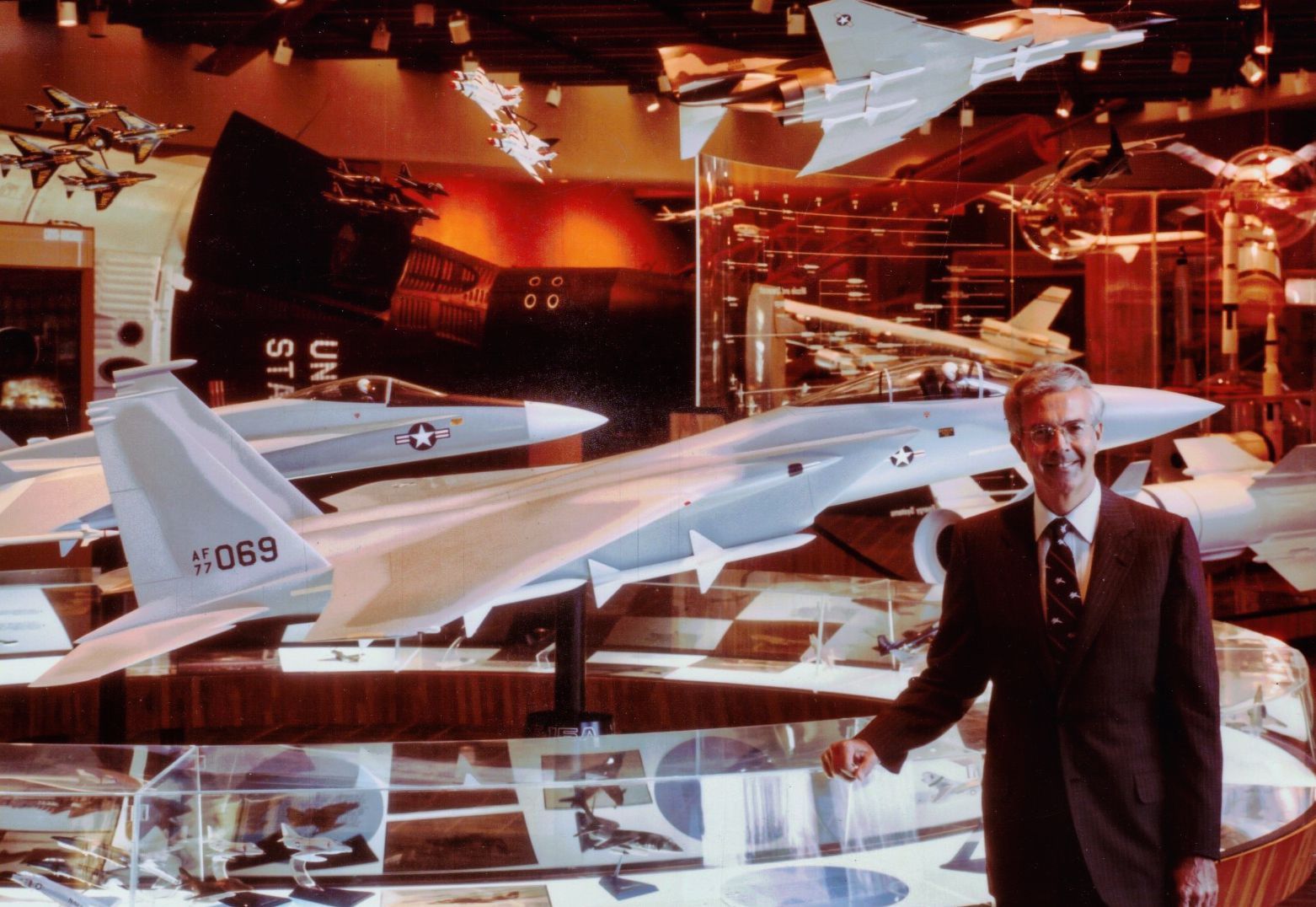
The iconic aircraft that McDonnell Douglas had designed and built over so many years like the F-15, F-18, C-17, T-45 were quickly relabeled as Boeing aircraft. The MD-95 airliner was renamed the Boeing 717. The name “McDonnell” that had once been so iconic it had been prominently displayed in “James Bond” movies and the movie “The Right Stuff” was as quickly as possible being purged from the national consciousness. During one episode of the comedy show Seinfeld, Jerry is talking about how well his electric toothbrush is built and hypothesized that it must have been built by McDonnell Douglas. Around 1980 McDonnell Douglas got recognition for the fact that if you had one dollar to invest in 1940 you would have done the best by investing in McDonnell Aircraft, the predecessor to McDonnell Douglas. This fact was also highlighted in the 1992 movie “Folks” starring Don Ameche and Tom Selleck where the two of them are near broke and the old weak father keeps mumbling about “McDonalds”, “McDonalds” and his son tells him that they can’t go to McDonald’s right now they don’t have the money. The father eventually shows his son the McDonnell Aircraft stock certificates that he bought back in the 40’s and they are rich.
Randy is still upset about a February 2021 article in Aviation Week from Richard Aboulafia that started by saying “Douglas aircraft started down a 30-year path toward extinction when it merged with McDonnell in 1967.” McDonnell had rescued Douglas from bankruptcy in 1967 and if the analysts on Wall Street were correct had also later rescued Boeing in 1997. McDonnell had also established the McDonnell Douglas Finance Company the year after the Douglas merger to loan money to the airlines to buy Douglas airliners. After the merger with Boeing, it was renamed the Boeing Capital company to help airlines buy Boeing aircraft.
Richard Aboulafia’s argument was that McDonnell management didn’t allow Douglas to develop enough new airliners. Randy believes just the opposite was true. He believes if McDonnell management hadn’t given in to Douglas management’s insistence on following Boeing’s big gamble into all new wide-body aircraft by developing the DC-10 and instead had developed a much less expensive DC-8 twin, McDonnell Douglas would be dominating commercial aviation today, Boeing would probably be a fraction of itself, and Airbus probably wouldn’t exist.
Also, his father had given in to Douglas Management by developing the MD-11 which wasn’t a twin-engined airliner, and it wasn’t part of a large family of aircraft with all those benefits like commonality in parts and training. In Randy’s opinion, just as Boeing wouldn’t have been able to compete with Douglas if the DC-8 twin had been launched, it didn’t make economic sense, without a technological breakthrough, for McDonnell Douglas to kill itself trying to catch up in commercial aircraft soon after the DC-10 was launched and quickly got a bad safety reputation.
Even before McDonnell Aircraft came along, Douglas had a history of developing too many new aircraft which may have contributed to the problems they had in 1967 when they had to be bought by McDonnell Aircraft. When Douglas developed the DC-9 they only used the existing cockpit window frames from the DC-8. Otherwise, it was a whole new aircraft. Boeing, when they built the 727 and 737 used much of the 707 fuselage, nose and cockpit section and achieved more commonalty advantages and were farther down the learning curve. The 757 also used the 707-fuselage cross-section. None of that occurred at Douglas.
In 1973, Douglas Aircraft management asked the McDonnell Douglas board to approve the development of a twin-engine version of the DC-10. Luckily Randy's cousin and Mr. Mac's son John McDonnell blocked the DC-10 twin from proceeding. Shortly after, the OPEC oil embargo hit in October of that year and the United States entered a recession as fuel prices quadrupled. Also, less than a year later in March 1974 was the first of two high profile DC-10 accidents. Also, by that time, Airbus already had a lead in developing a twin wide-body aircraft as a direct competitor to the DC-10 twin. Only two months after the March 1974 Turkish Airlines DC-10 crash, the A300 entered Air France airliner service with a significant lead over what would have been a DC-10 twin introduction.
Even though by the time of the MD-11 launch, the DC-10 had a good safety record it still had an undeserved reputation from these high-profile accidents early in its history. The first accident, a Turkish Airlines flight out of Paris was Douglas Aircraft’s fault and the first accident of a jumbo jet and largest death toll of any airliner accident at the time. All 346 passengers onboard were killed.
The second accident was because of an American Airlines’ improper maintenance procedure for changing engines where they changed both the pylon and engine together contrary to McDonnell Douglas procedures and raised both with a fork lift truck. The slamming of the pylon on the under-side of the wing caused the problem. The pilots also could have continued the flight and flown around for a landing but they slowed the aircraft down to its speed for best angle of climb and backed into the problem. If they had needed to clear a building or mountain that would have been the correct action.
However, the rule when piloting an aircraft and everything is stable is to figure out the situation before changing anything. The leading-edge slats on one side of the aircraft had retracted due to the damage to the leading edge of the wing from the engine and pylon ripping up and over the wing as it left the aircraft. One wing stalled and the DC-10 rolled too fast, too close to the ground.
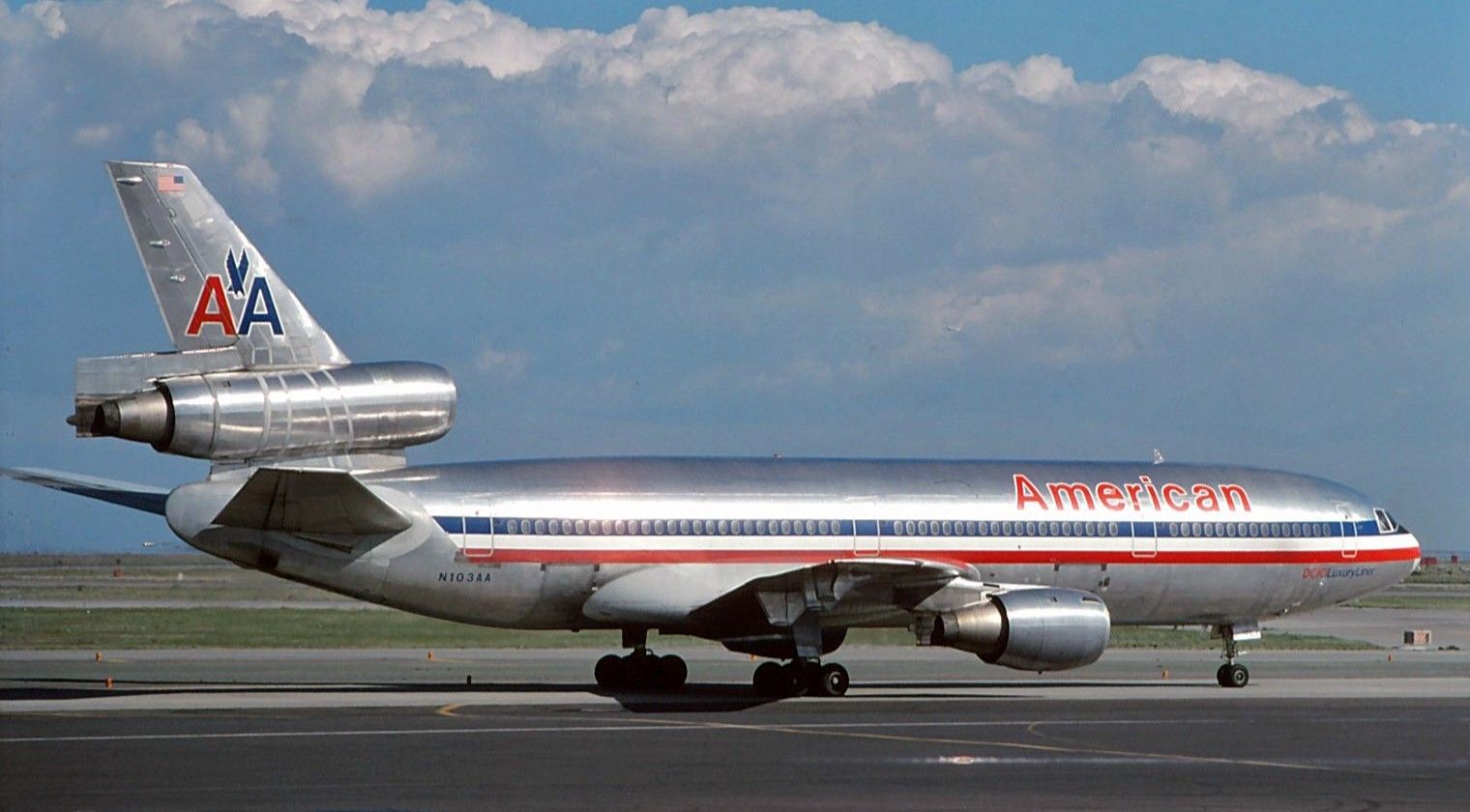
The accident occurred taking off from O’Hare airport in Chicago and was caught on film as it rolled over at a 400-foot altitude and dove into the ground killing all 277 on board. It was the largest airliner death toll on American soil at that time.
Because the McDonnell family was never into pointing the blame at others even when it was true, they never pointed out to the public that the fatal accident was caused by American Airlines violating their maintenance procedures. They also never mentioned that the pilots could still have avoided the accident if they had used the generally accepted procedure when an aircraft is stable to figure out what had happened before changing anything. As a result the public assumed the DC-10 was again at fault. Randy has allowed me Derek Hanchi, his videographer, website builder and aviation enthusiast, to include this lengthy article about what happened to McDonnell Douglas because its history has been so distorted. As a child, I had a model of the DC-10 in my room and witnessed that DC-10 Chicago crash as an 8-year-old driving by with my father.
Randy would lose about half his net worth in McDonnell Douglas stock soon after the merger in 1997 as what had been McDonnell Douglas stock was swapped for Boeing stock. Right after the merger the stock was at $60 a share. Soon after, the stock market became aware of the problems at Boeing’s Seattle plants and the stock dropped to $33 before Randy sold his shares and got to a low of $27.
Later Randy was sorry he sold his Boeing stock at $33 a share because the stock kept rising and rising and Randy felt that Dennis Muilenburg must be doing a great job as President and CEO of Boeing. Since it was no longer McDonnell Douglas and he had sold his shares, Randy wasn’t following what was happening but it was probably because of the stock buyback program.
In December of 2013 there was a black-tie dinner at the McDonnell planetarium in Saint Louis. This event was in honor of the McDonnell family on the 50th anniversary of the James S. McDonnell planetarium. While everyone was eating, Dennis Muilenburg made a special point of standing up at dinner, coming over and acknowledging Randy, his mother, Pris and his wife at the time, Veronica, while they were seated at their table. He was the only one in the entire room standing at that time. He then returned to his own table. Randy was greatly honored to get such a gesture. James S. McDonnell III was seated at the same table as Randy. Jim was Mr. Mac’s eldest son, had worked for McDonnell Douglas over 10 years longer than Randy, had risen to a higher level and had contributed more to the success of the corporation than Randy. Despite this, Dennis was giving more attention to Randy than to Jim.
Randy hypothesized that Dennis Muilenburg had either heard about Randy’s biggest secret invention or because Randy had filed a lawsuit almost two years earlier to finally get paid for his invention that he had gotten both Boeing and Insitu interested in. Insitu had in a short period of time dropped from 10 employees down to 3 per one of the three remaining employees who wanted to go back to work for Randy on one of his stopped rotor aircraft projects that he had started after leaving McDonnell Douglas in 1993. After Randy sent Insitu his patent, it became the 30th fastest growing technology company in North America in 2006 per the Deloitte Technology Fast 500 list.
Randy’s invention would make possible a family of aircraft that could reliably land like a bat with a hook on the leading edge of the wing. That is also where the thumb is on a bat. It allowed the aircraft to land on a line hanging vertically without need for wheels, tires, brakes, nose wheel steering, landing gear struts, wheel wells, doors, extend retract mechanisms or runways. Randy had been the interface between Boeing and Insitu for a while and then just asked Boeing to communicate directly with Insitu.
Boeing then bought Insitu in 2008 for $400 million and claimed they didn’t infringe Randy’s patent. Randy’s father didn’t want Randy to sue what used to be McDonnell Douglas so Randy refrained for as long as he could, trying to negotiate a fair deal until the statute of limitations would have started to run out. It had been almost 14 years since he had shared his patent with Insitu and almost 10 years since his invention had been used in Iraq, Afghanistan, Libya and wasn’t that far from a million combat flight hours. Boeing and Randy would eventually come to a mutually agreeable settlement.
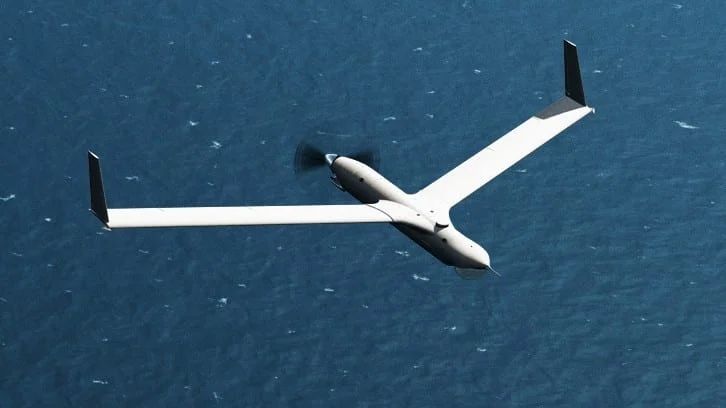
One of the bat planes based on Randy’s patent was used to help save the captain of the Maersk Alabama from Somali pirates that was documented in the major motion picture “Captain Phillips.” It was the only unmanned (or drone) fixed wing aircraft operating off Navy ships.
Earlier in 2009 there had been a large black-tie dinner at St. Louis’ James S. McDonnell Planetarium to honor the McDonnell family on the 50th anniversary of the first moon landing. Randy had lamented to John McDonnell’s wife Anne how sad it was that the McDonnell Douglas name had been lost. She estimated that in 100 years the memory of McDonnell Douglas would be gone. Ten minutes later, the president of the Science Center, Doug King, would give his estimate. He got up on a high podium with a microphone and stated to the assembled audience…”a thousand years from now people will remember how the United States went to the moon and the critical role that McDonnell Douglas played in that drama.”
Randy wasn’t sure who would be correct but he always thought that McDonnell Douglas would long outlive him. His whole life he was most proud of his grandfather, great uncle, father and McDonnell Aircraft and then McDonnell Douglas.
The planetarium often had memorabilia from McDonnell Douglas and Randy also had a room in his house designated to display his extensive collection of McDonnell Douglas models, books, clothing, and memorabilia. This room represented the past. The room next to it and a hidden portion of the basement had working models of what Randy believed would reshape aviation.
In contrast to the way Boeing treated McDonnell Douglas teammates and stockholders and appeared to want to eliminate or destroy the legacy of McDonnell Douglas, the McDonnell family had honored the Douglas family and company history.
In 1967 Douglas Aircraft had gotten into the same kind of problems that Boeing found itself 30 years later in 1997. They had sold too many aircraft at too low a price and were now far behind schedule and having to pay penalties to the airlines for late deliveries. They didn’t have enough skilled workers or engineers and aircraft were being assembled out of sequence at high cost.
Despite that McDonnell Aircraft made a point of honoring and respecting the Douglas name, company, family, and employees. All the Douglas plants retained the Douglas name. The Douglas name was also added to the corporate name to yield “McDonnell Douglas.” The DC-8, DC-9 and DC-10 were not renamed. “DC” still stood for “Douglas Commercial” or “Douglas Cargo.” Mr. Mac had voluntarily given Donald W. Douglas Sr. the title of Honorary Chairman of the board of McDonnell Douglas.
In the 1967 Annual Report for McDonnell Douglas, Mr. Mac placed Donald W. Douglas’ picture at the top left of the first inside page in the most prominent position, and a more prominent position than his own. This was despite the fact that Mr. Douglas only held an honorary position and Mr. Mac was the Corporation’s Chairman and Chief Executive Officer and before the merger, Mr. Mac had owned 33 times as much stock in Douglas Aircraft as the Douglas family. Mr. Mac also placed a picture of Donald W. Douglas Jr. on this first inside page. There were twice as many Douglases as McDonnell’s highlighted in this way in the first annual report of the combined companies even though McDonnell Aircraft had saved Douglas Aircraft from going into bankruptcy and there were five McDonnells, four of which were engineers, working for the combined company or on the board, including two of Mr. Mac’s own sons, John and James S. McDonnell III and his nephew Sandy McDonnell.
Over time McDonnell continued to respect and honor the Douglas family and employees. During the 1970 Roll-out and 1971 delivery ceremonies of the DC-10, Mr. Mac gave Mr. Douglas a greater role in the festivities. Mr. Douglas made a grand entrance to the DC-10 delivery ceremony by landing in a restored mint condition DC-3 along with glamorous film star of the 1920’s and 1930’s, Gloria Swanson. Spectators waiting for the delivery ceremony crowded around as Mr. Douglas, Gloria Swanson and C.R. Smith, former chairman of American Airlines exited the plane. Mr. Mac just walked over to the ceremonies. In the 20-year celebration of McDonnell Douglas in 1987, Donald Douglas is seen on the left side of the collage below in an equal or better position with Mr. Mac.
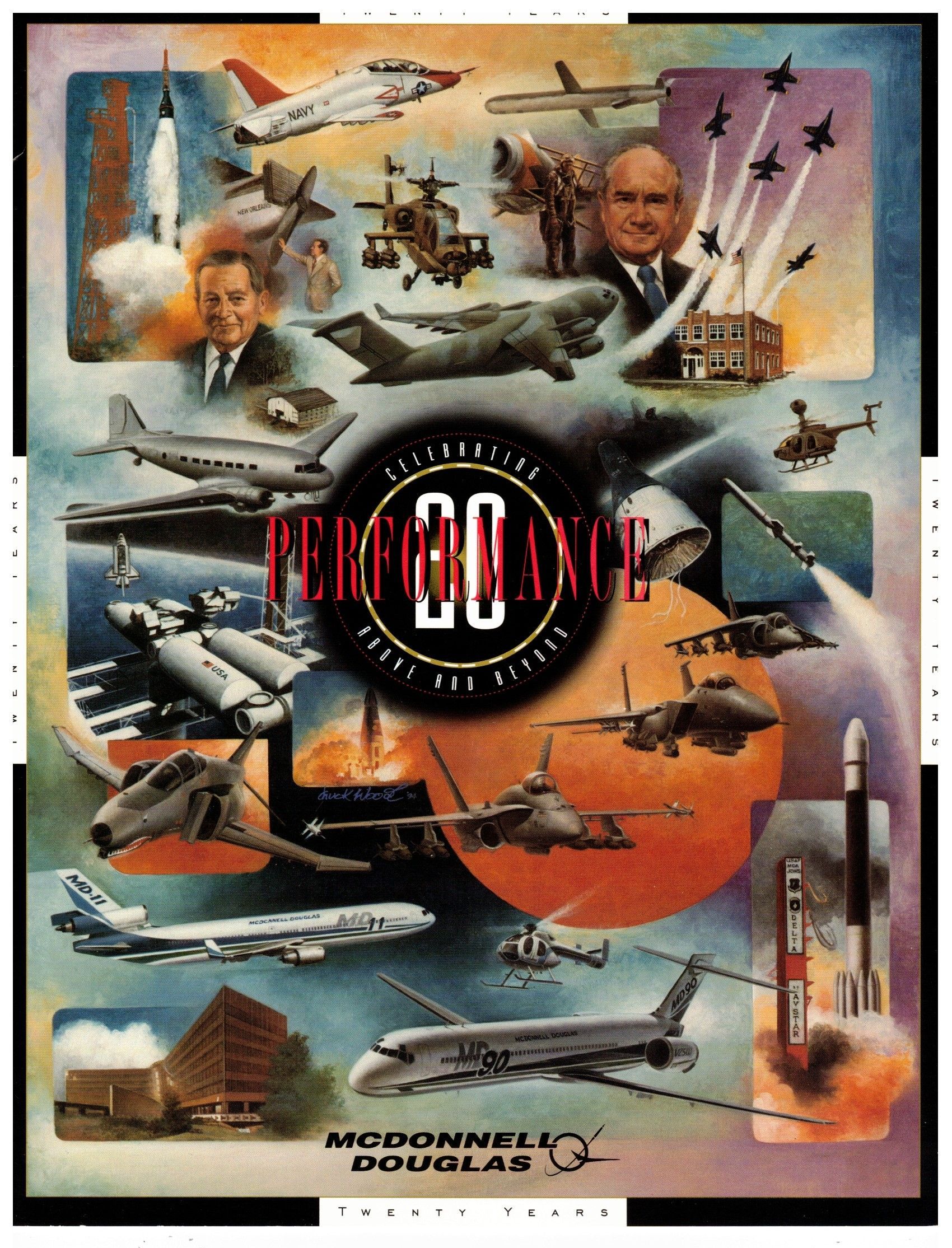
Randy believes that the biggest failures in the US commercial aircraft industry were failures in “making decisions that maximize the benefit to everyone affected by those decisions” which were the 12 words at the center of the McDonnell Douglas ethics training program and are now the centerpiece of his two websites “FixAllDemocracies.com” and “RaceToABetterWorld.com.”
Mr. Mac exemplified those 12 words. He wasn’t building airliners, he was building “magic carpets to bring people together for a more peaceful world.”
He cared very deeply for his employees whom he called “teammates.” He preferred the term “comrades” but said that the communists had claimed the term first. He had a photographic memory and knew details about thousands of teammates and their families. Randy was told by a teammate that Mr. Mac had followed him one day into an elevator. He didn’t know what to do but Mr. Mac put him at ease and asked what his name was and what department he worked in before the door opened and they went their separate ways. Seventeen years later he ran into Mr. Mac again and Mr. Mac addressed him by name and asked about the department he had been in seventeen years earlier.
When Randy’s grandmother died, Sandy suggested to his son that he buy his grandmothers Cadillac. Randy asked his father why, as a young bachelor, would he want to give up his sporty new Audi Fox for a large clunky old folks Cadillac that was 11 or 12 years old at the time. Sandy argued that every time his son drove the car he would be reminded of his beloved grandmother. His son greatly respected his father and didn’t like to turn him down on anything he suggested or felt was the right thing to do. After his son had agreed to buy the car, Sandy made him buy it at approximately 25% more than blue book value to make sure they wouldn’t be short changing the death taxes due. For the next five years the son was often being asked why in the world he drove that old Cadillac.
Sandy emphasized ethics in all areas of his life. Whenever his son was driving, and went more than a few miles per hour over the speed limit Sandy would notice and ask his son to stop speeding. His son quickly learned not to point out that everyone else was zooming past them and that the police won’t stop you until you are more than 10 mph over the speed limit. That didn’t matter; he was still breaking the law.
If Sandy McDonnell used a single stamp for personal use, he would make sure he paid for it and not the American tax payers. In the 1980’s there was a justice department investigation into military contractors and they found that Sandy McDonnell had saved pocket planners that documented everything he had done every day for his entire career at McDonnell Aircraft and then McDonnell Douglas. They felt sure they would find some good dirt. They studied the pocket planners for months and finally gave up, disgusted that they had found only ethical behavior.
Randy remembers his father bragging, when he was Chairman and CEO of McDonnell Douglas, that he was being paid at the VERY BOTTOM OF THE PAY SCALE for CEOs of a company their size. He didn’t have to be paid a lot to know he was doing a great job for the American taxpayers.
Randy is dedicating this website to the legacy and inspiration he received from his grandfather, great uncle, father and their family company from the time he was a small child.
THE DRAMATIC IMPACT OF THE 12 WORDS ON THE U.S. FIGHTER AIRCRAFT INDUSTRY
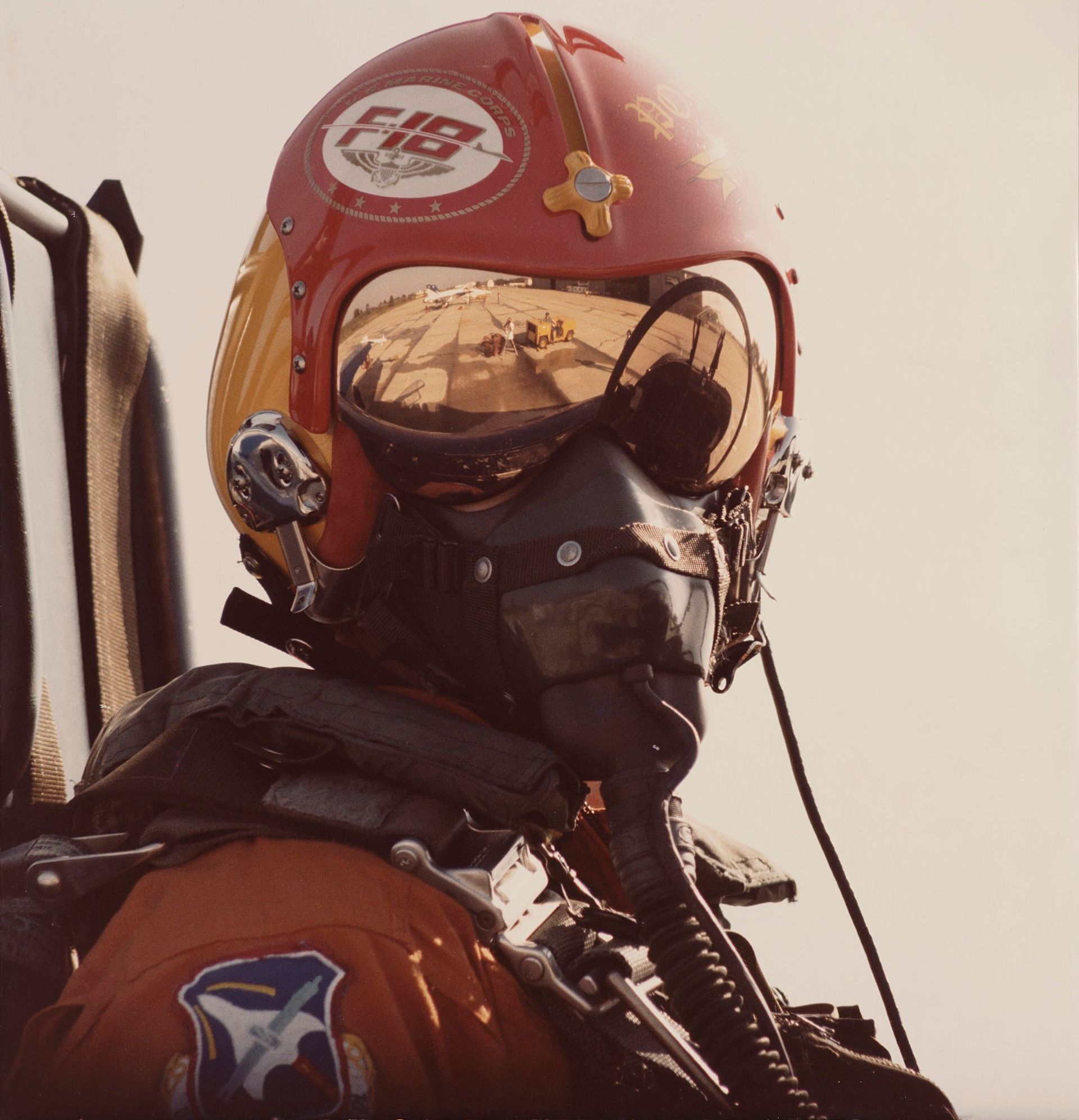
Randy believes if it weren’t for Mr. Mac there wouldn’t have been the F-4 and F-15, back-to-back deemed the most successful fighters of their times by Aviation Week. McDonnell Aircraft had also proven that it could mass produce fighter aircraft. At one time more than seventy F-4s were being produced a month.
Randy also believes there wouldn’t have been the F-16 without Mr. Mac who groomed David Lewis to take over McDonnell Douglas after him. Mr. Mac had trained David Lewis to be the head of advanced design for McDonnell Douglas before he left to take over General Dynamics and won the F-16 program. Lack of loyalty is a potential disadvantage of not having a family member as a planned successor. Mr. Mac had trained the man that made General Dynamics his biggest competitor in the fighter business. Even worse he had moved General Dynamics headquarters to Saint Louis, where McDonnell Douglas was located.
Randy was working on a project with another student in the MBA program at Washington University in Saint Louis late at night and they needed copies of their report. The other student said they could make copies at his office. Randy didn’t know where this student worked until he was being led into the headquarters building of General Dynamics. Randy told the student that he shouldn’t be allowed in without a badge but he insisted it was Ok and let them both in with his badge.
Randy was nervous the whole time wondering what would happen if Dave Lewis walked by and found him late at night in his headquarters building copying documents.
When Lockheed acquired the F-16 program from General Dynamics, it appears they didn’t acquire the ability to mass produce fighters like Mr. Mac trained McDonnell Douglas or General Dynamics.
Mr. Mac had built McDonnell Douglas’ aircraft design approach and probably influenced General Dynamics’ approach as well through Dave Lewis for mass produced fighters which appeared unbeatable for hundreds of small reasons. For example, if you were looking at a part number that ended in a dash followed by an odd number you knew the next highest number would be the mirror image drawing for the opposite side of the aircraft. Randy was told that at Lockheed you had no idea what the part number was for the same spot on the other side of the aircraft and there might not be a mirror image drawing. Randy isn’t sure that is true but that’s what he heard.
The Navy liked the Northrop entry into the Lightweight fighter program so they chose the F-17 but insisted that McDonnell Douglas be the lead for developing the F-18 because McDonnell Douglas had the experience to build a Navy fighter.

So how could McDonnell Douglas lose large production programs like the F-22 and F-35 programs to a company that wasn’t able to efficiently build mass produced fighters? Lockheed was great at silver bullets like the U-2, F-117 and SR-71 but not mass produced fighters.
Randy’s father admitted that he had made a mistake that Mr. Mac probably wouldn’t have made. Sandy had been approached by a retired General that had amazing contacts in the Air Force and claimed he would be a good salesman to make sure the Air Force knew the amazing advantages of the Northrop/McDonnell Douglas F-23 entry. After the competition was over Sandy was told that his consultant had made the evaluators mad, that had the power to determine which aircraft was going to win, by going over their heads to Air Force generals.
The McDonnell family has a history of living into their 90s and Mr. Mac's brother lived to 93. However Mr. Mac died at only 81 and less than a year and 3 months after the DC-10 became the aircraft associated with both the largest loss of life in aviation history at the time from the Turkish Airlines crash and the largest loss of life over American soil with the American Airlines crash. Randy believes that if Douglas Aircraft hadn’t insisted on developing the DC-10, that Mr. Mac wouldn’t have been stressed by the aircraft’s accidents and financial problems and would have lived long enough not to have made the mistake of hiring a consultant. Mr. Mac believed that a good product should sell itself. Unlike the Navy, the Air Force didn’t demand that McDonnell Douglas be the lead on the F-22 production program. Randy believes that contributed to the cost over-runs and the program being canceled after only 187 production aircraft were built. However, in air-to-air combat, the F-22 would go on to have a spotless record — just not against fighter aircraft. In two separate incidents in February 2023, Raptors shot down a Chinese spy balloon off the coast of South Carolina as well as an “unidentified object” over Alaska in Jun 6, 2023.
Randy believes that the Air Force made another mistake by not following the Navy example on the F-35 production program and making what had been McDonnell Aircraft the lead. A former McDonnell Douglas executive who didn’t want to be named but had a high position in Boeing after the merger told Randy something interesting. An Air Force general told him that he should ask Lockheed for a large portion of the production program because the general wasn’t convinced Lockheed could mass produce the F-35. It was too late because Lockheed had already teamed with British Aerospace and had given away too much already to give any more to what had been McDonnell Aircraft, now Boeing.
Colonel Jack Jackson, who was McDonnell Douglas’ chief pilot on the AV-8B Advanced Harrier and the man with the most hours in that aircraft type told Randy that he had been offered a tour of the F-35 assembly line. He noticed orange flight test wiring going into production aircraft which was a sign they were still having problems with the aircraft even though they were already well into mass production.
Now 26 years after the merger, Boeing is still building those same iconic McDonnell Douglas designed fighters, the F-18 of the latest Top Gun movie and the F-15 that has a 104 to zero record in air-to-air combat.
Randy contributed to the design of the F-18 inboard and outboard wings, was the flight test engineer on the F-18 carrier suitability program and was the 59th person to ever fly the F-18 and only the third person to fly it over a foreign country.
